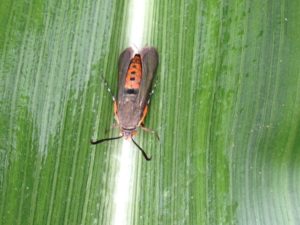Sweet Corn
European corn borer (ECB) moth catches in black light traps remain very low; situation unchanged from last week. There will be no map in this edition due to insufficient catch. Incidents of feeding are declining as infested plantings proceed to silk and whorl stage corn has not been exposed to egg laying. We should be in a period relatively free of whorl infestations now. The next whorl infesting pest will be fall armyworm (FAW). As yet, no infestation of this pest have been detected. Once plants hit full tassel, ECB larvae will move downward on the stalk and re-enter the plant near the area where ears are forming. This can result in direct injury to the ear. Growers should consider an insecticide application at the full tassel stage to target ECB larvae as they migrate downward. This application can eliminate larvae that have escaped any earlier insecticide applications.
The highest nightly trap catches of ECB for the week ending 7/04/18 are as follows:
| Crosswicks 1 |
| East Vineland 1 |
| Eldora 1 |
| Medford 1 |
Corn earworm (CEW) moths have declined in black light traps this past week. Numbers are too low now to gemerate a map image. In addition, the CEW pheromone trap catches in the southern counties have declined as well, although the sensitivity of this trap type still permits an image to be produced. (see CEW pheromone trap map at lower 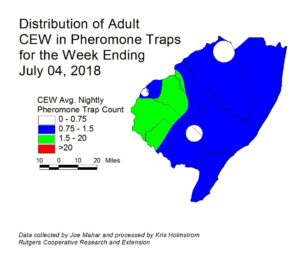 right). The pheromone trap catch does not directly correspond to the schedule prescribed by the blacklight traps, as the pheromone traps capture males at an increased rate, especially prior to the large migrations of late summer. Additionally, there are many fewer pheromone traps than blacklight traps. This results in much broader colored patches on the pheromone maps. The blue area on the pheromone map indicates an approximate 6 day silk spray schedule.
right). The pheromone trap catch does not directly correspond to the schedule prescribed by the blacklight traps, as the pheromone traps capture males at an increased rate, especially prior to the large migrations of late summer. Additionally, there are many fewer pheromone traps than blacklight traps. This results in much broader colored patches on the pheromone maps. The blue area on the pheromone map indicates an approximate 6 day silk spray schedule.
The highest nightly black light trap catches of CEW for the week ending 7/04/18 are as follows:
| East Vineland 1 |
| Pedricktown 1 |
| Woodstown 1 |
The highest nightly pheromone trap catches of CEW for the week ending 7/04/18 are as follows:
| Monroeville 3 | Elm 1 |
| Woodstown 3 | Green Creek 1 |
| East Vineland 1 | Jobstown 1 |
Silking Spray Schedules*:
South – 6 days
Central – 6-7 days
North – 7 days
*These recommendations are based on regional catches. Adhere to tighter spray schedules if indicated by local trap catches.
Pepper Weevil
One weevil was caught in the past week in the field near the Hammonton area. It is unlikely that a field population has been established in this field.
Tomatoes
There has been a slight increase in the appearance of native brown stinkbugs in black light traps this past week. As we progress from June into July, it is worth noting that this is typically the time of the season 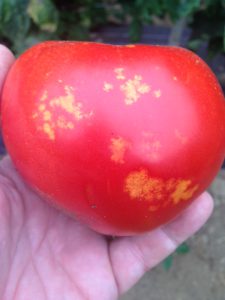 when our native brown stinkbugs become active; seeking sites on which to feed and lay eggs. This can be an economic problem for our field tomato plantings. Stink bug feeding results in pale blotches on green fruit, that turn yellow as the fruit ripen to red (see photo at right). Picking crews often notice this damage first, as they see the greatest volume of overall fruit. If this damage is increasing, and/or adults, nymphs or egg masses are occurring in scouting samples, consider treating. See the tomato section of the 2018 Commercial Vegetable Recommendations Guide for appropriate materials.
when our native brown stinkbugs become active; seeking sites on which to feed and lay eggs. This can be an economic problem for our field tomato plantings. Stink bug feeding results in pale blotches on green fruit, that turn yellow as the fruit ripen to red (see photo at right). Picking crews often notice this damage first, as they see the greatest volume of overall fruit. If this damage is increasing, and/or adults, nymphs or egg masses are occurring in scouting samples, consider treating. See the tomato section of the 2018 Commercial Vegetable Recommendations Guide for appropriate materials.
Brown marmorated stink bug (BMSB)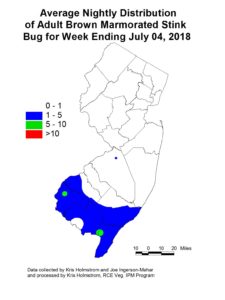
BMSB catches in black light traps increased in parts of southern NJ this past week. The population was not particulary high, but bayshore area traps captured enough to generate a map image. Although this pest has not had serious impact on vegetable crops like peppers in recent years, it is still a significant pest of tree fruits.
The highest nightly trap catches of BMSB for the week ending 7/04/18 are as follows:
| Woodstown 12 | Green Creek 2 | Crosswicks 1 |
| Eldora 9 | Jobstown 2 | Jones Island 1 |
| Centerton 4 | New Egypt 2 | Old Bridge 1 |
| East Vineland 3 | Pedricktown 2 | Tabernacle 1 |
Squash vine borer moths are active now, and may cause injury to crops like summer squash. The moth (see photo at right) is typically active at dawn and dusk, and will lay eggs on the base plants that have sufficient stem width to support the larva. Larvae hollow out the main stem, causing a wilt condition to occur. Insecticides in the IRAC classes 28 (Coragen, Exirel), 5 (Radiant, Entrust (OMRI approved)) and 4A (Assail) may be used effectively against this pest, but should be applied weekly while moths are active. Other materials are also labeled and may be found in the Summer Squash section of the 2018 Commercial Vegetable Production Recommendations Guide. Generally, 4 applications at weekly intervals are enough to avoid most injury from this pest during the egg laying period.
Pumpkins and Winter Squash
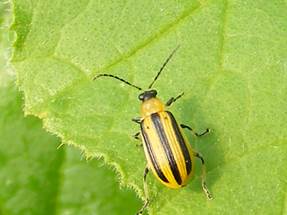 Pumpkins are now up in many areas. It is critical that these fields be scouted while plants are in the 0-4 true leaf stage. Striped cucumber beetle (see photo at left) is the most serious pest of these crops in this stage, not only because they cause direct injury to seed leaves and true leaves, but because at this stage, the beetles can transmit the bacteria that cause in bacterial wilt. Check 5 plants each in 10 random locations. If beetles are found actively feeding in 2 or more sites, consider an insecticide application to reduce the likelihood of bacterial wilt setting in later. Many pumpkin and winter squash seeds are purchased with a seed treatment that includes a neonicotinoid insecticide. In this case, cucumber beetle feeding should be seriously limited for the first 2-3 weeks of growth. This is typically long enough to get the plants close to the stage where vines begin to run or bush out. At this point, it is much more difficult for the plants to acquire a large enough bacterial load from the beetles to cause wilt. Organic growers of these crops should consider covering plants from emergence through just before vine run. This should limit beetle feeding and permit bee access to blossoms when the covers come off.
Pumpkins are now up in many areas. It is critical that these fields be scouted while plants are in the 0-4 true leaf stage. Striped cucumber beetle (see photo at left) is the most serious pest of these crops in this stage, not only because they cause direct injury to seed leaves and true leaves, but because at this stage, the beetles can transmit the bacteria that cause in bacterial wilt. Check 5 plants each in 10 random locations. If beetles are found actively feeding in 2 or more sites, consider an insecticide application to reduce the likelihood of bacterial wilt setting in later. Many pumpkin and winter squash seeds are purchased with a seed treatment that includes a neonicotinoid insecticide. In this case, cucumber beetle feeding should be seriously limited for the first 2-3 weeks of growth. This is typically long enough to get the plants close to the stage where vines begin to run or bush out. At this point, it is much more difficult for the plants to acquire a large enough bacterial load from the beetles to cause wilt. Organic growers of these crops should consider covering plants from emergence through just before vine run. This should limit beetle feeding and permit bee access to blossoms when the covers come off.
